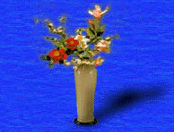
![]()


![]()

Ching Dynasty ( 18th century ) Study Room Flower Arrangements and
Potted Plants
Flowers: Chrysanthenmums
Vessels: Porcelain cistern
Flower style: Cistern flower arrangement
Potted plants enjoyed enormous popularity during the Ching Dynasty.
Curio stands containing from just several to as many as 30 different potted
plants were a common fixture in many rooms. Flower arranging was shaped
by this trend, and the number of arrangements appearing in pots or alongside
potted flowers rose dramatically. Methods of arranging and styles also
imitated those of the potted combinations, partly a result of the strong
realist influence of the time.
Offertory flowers with calligraphy as a backdrop are often found in traditional Chinese study rooms. To liven up a composition and balance the solid and empty spaces, the light and the heavy, decorative objects such as a Chinese knot, a fly whisk, or smoldering incense are often added. The fresh flowers and bergamot in this omposition provide a striking color contrast, injecting new vigor into ancient austerity.
![]()
The study of antiquity and historical verification reached a peak of popularity during the Ching Dynasty. Flower arranging and the collection of antiques, including the numerous vessels in which flowers were displayed, were very much in vogue. Peonies and early pink make up the core of this composition. Large peonies reach upward and to the left while smaller peonies guard the mouth of the vase, forming a triangle with the early pink. The incense brazier and the szu kuang at center provide a feast for both the nose and the eyes.


![]()
[preface] [
styles] [religious]
[palace]
[literati]
[folk] [9 pricniples]
[significance] [preveration]
[vessels] [appreciatin]
[Pavilion of Taiwan,
R.O.c] [Cultures]
[Council For Cultural
Affairs]